The exhilarating pace of tennis is celebrated worldwide for its daytime play. However, for nighttime practice or competitive matches, adequate lighting becomes crucial. Discover the essential role of LED lighting for tennis courts and how it enhances visibility. Whether you prefer playing tennis indoors or outdoors, you’ll gain insights into the current industry standards for lighting specifications.
While the game of tennis itself has remained relatively unchanged over the past 150 years, advancements in lighting technology have been significant. Today, tennis can be enjoyed in well-lit indoor environments and under the night sky. Explore the benefits of modern tennis court lighting layouts and understand why they are essential for the game.
Table of Contents
ToggleWhat is Tennis Court Lighting?
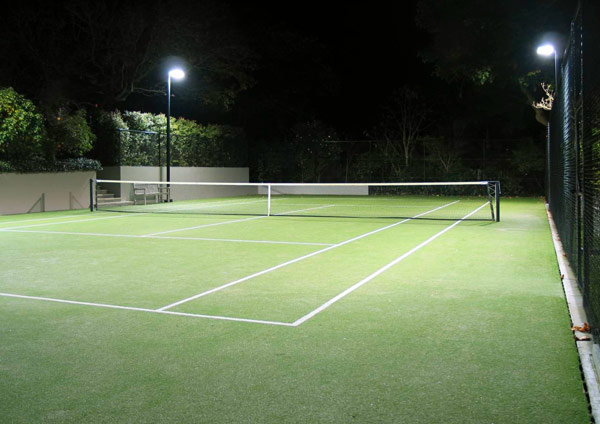
It’s fascinating to consider that it has only been 45 years since the US Open started broadcasting nighttime tennis matches in 1975. Before this, the history of night tennis is somewhat hazy, but records show that night play began as early as 1879, thanks to Thomas Edison’s innovations with carbon-thread incandescent bulbs. In a notable nighttime match held behind a factory in Boston, three towers provided a combined light intensity equivalent to 90,000 candles.
The journey of tennis court lighting saw a significant evolution when the NFL introduced night-time floodlights in 1929. This lighting technology was later replaced in 1959 with metal halide lights, which were then adapted for tennis courts and various other sports. Although metal halide lighting saw use in private clubs, universities, and residential courts, it wasn’t until 1975 that it was prominently mentioned in the context of tennis. The landscape of tennis court lighting underwent a major transformation in the mid-2010s with the advent of LED sports lighting.
Today, tennis court lighting is a sophisticated field that involves balancing color temperatures and adhering to industry standards. Modern lighting systems are designed to replicate daylight conditions on the court, ensuring that players receive uniform illumination. This includes all areas of the court, from the service box to the defense zones, and even extends to the doubles sidelines. In professional competitions, lighting efficiency has become more refined and technologically advanced.
Why Do We Need Tennis Court Lighting?
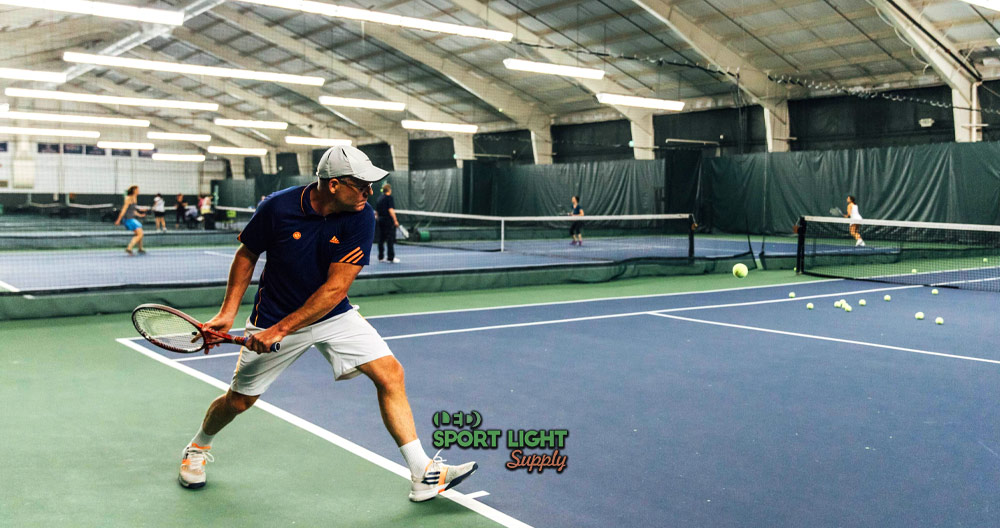
There are several compelling reasons for incorporating lighting into tennis courts, whether they are indoors or outdoors. Natural light limitations necessitate the use of artificial lighting to ensure optimal visibility for both players and spectators. Properly implemented lighting enhances the viewing experience, making it possible for large audiences to follow the action. Additionally, high-quality lighting is crucial for capturing clear images and videos, as it prevents quality loss in television broadcasts and digital photography.
Effective lighting ensures that players can clearly see their opponents and track a fast-moving ball, no matter where they are on the court. The design of the lighting layout provides consistent illumination, minimizing shadows and ensuring that light coverage is even from all directions. This prevents the formation of repetitive shadows and maintains a high level of visibility throughout the match.
Regardless of whether the court is indoors or outdoors, the lighting can be adjusted to achieve the appropriate Color Rendering Index (CRI) and color temperature. These factors are essential for providing the best possible vision levels during professional and semi-professional tournaments. Modern tennis court lighting systems are not only suitable for high-profile events but can also be adapted for residential use, offering high-quality lighting solutions tailored to various needs.
Types of Tennis Court Lighting
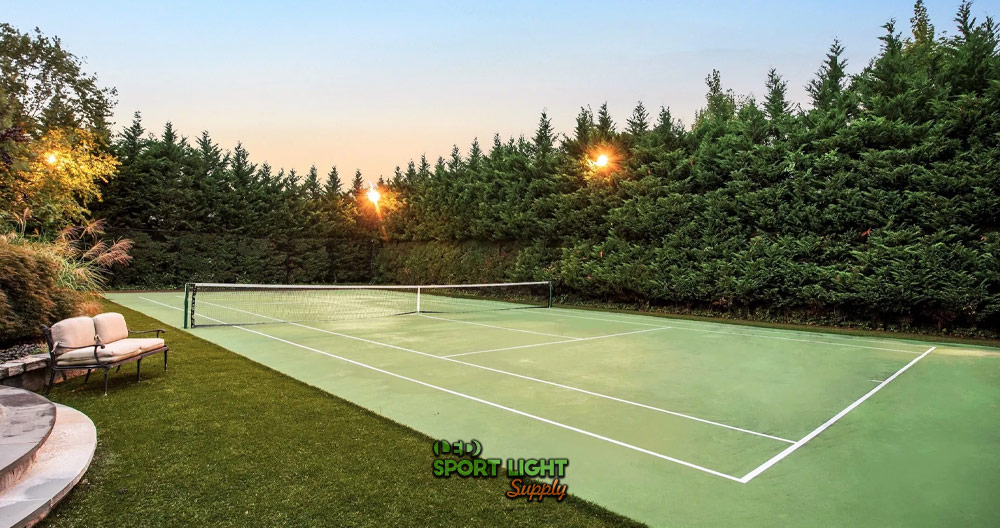
Residential Lighting
Many homeowners with backyard tennis courts often forgo installing lighting for nighttime use. However, adding lights can significantly extend the usability of evening matches. LED floodlights are an excellent choice for residential tennis courts because they offer high brightness while consuming less wattage. This efficiency allows you to enjoy well-lit games without the excessive energy costs associated with traditional lighting.
Commercial Lighting
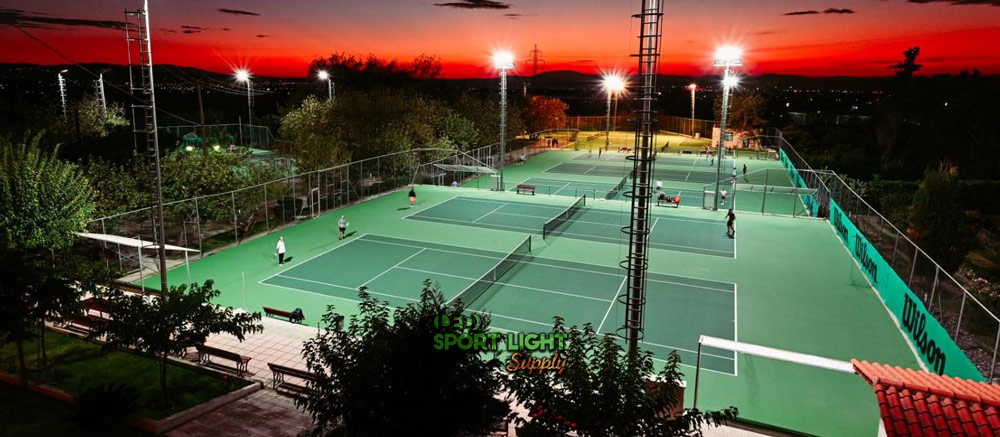
Commercial tennis courts, found in schools, tennis clubs, and outdoor recreation facilities, frequently benefit from upgraded or retrofitted lighting systems. These courts often use high-performance lighting that meets the demands of both recreational and competitive play. Commercial lighting systems are designed with refined color temperatures and Color Rendering Index (CRI) levels to enhance visibility and provide optimal conditions for tournaments and semi-professional matches.
Outdoor Tennis Court Lighting
Outdoor tennis courts typically feature lights mounted on poles situated just outside the court. Recent advancements include outdoor panel designs equipped with solar panels that charge external batteries, enabling lights to operate without direct electricity. These systems can be mounted on high masts or rooftops and provide up to 3.5 hours of light, which is especially useful during power outages or for locations without reliable electricity.
Indoor Tennis Court Lighting
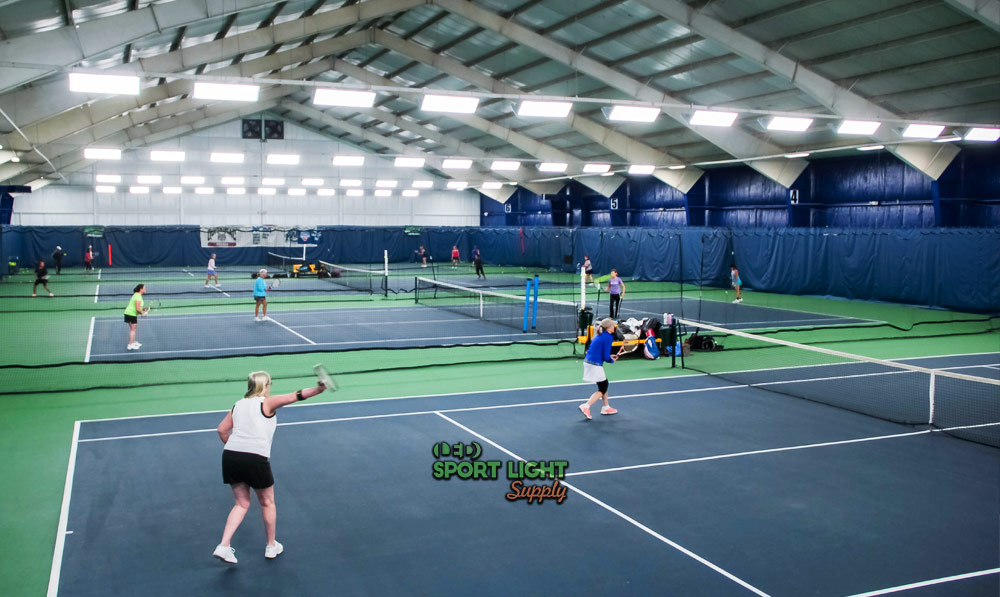
Indoor tennis courts achieve illumination through fixtures mounted on suspension beams, ceiling brackets, or the upper edge of walls. This flexible mounting allows for customized lighting arrangements to suit different needs, whether for competitive play or recreational use. Proper indoor lighting ensures that the court is well-lit, providing a consistent and comfortable environment for players.
Portable Tennis Court Lighting
Portable lighting solutions are ideal for situations where permanent fixtures are not feasible. Portable light towers can be quickly deployed to provide the necessary illumination for any tennis court. These mobile lights are particularly useful for television broadcasts and last-minute lighting needs, as they are equipped with high-powered LED lamps designed for comprehensive sports lighting coverage.
Different Classes of Tennis Court Lighting
| Class | Description | Key Features |
|---|---|---|
| Class I | Reserved for professional-level competitions; strict standards for color temperature, CRI, GR, Lux, and foot-candles. | High precision and brightness. |
| Class II | Used for college-level and semi-professional play; slightly lower foot-candle values than Class I. | High quality with excellent visibility. |
| Class III | Applied to high school courts and private clubs; cooler white color temperature and slightly lower ratings. | Adequate for competitive and recreational play. |
| Class IV | Used in recreational centers, local city courts, and public courts; varied quality, suitable for casual play. | Basic lighting suitable for general use. |
Class I
Class I lighting is reserved for professional-level competitions, including events sanctioned by organizations such as the USTA, ITF, and the US Open. This class of lighting adheres to strict specifications, including a specific spectrum of color temperature and high standards for Color Rendering Index (CRI), Glare Rating (GR), and Lux levels. The illumination must be precise, with specific foot-candle measurements designed to meet the rigorous demands of high-profile night-time tennis matches.
Class II
Class II lighting is designated for college-level and semi-professional play. While still high-quality, it has slightly lower values for foot-candles compared to Class I lighting. This class maintains high standards for CRI, GR rating, and Lux levels, making it suitable for serious training and competitive play. The lighting provides excellent visibility and quality, though it is not quite at the level required for professional tournaments.
Class III
Class III lighting is used for high school courts and private clubs, offering a good standard of illumination for quality tennis play. The color temperature is typically a cooler white compared to the daylight simulation of higher classes. While the CRI, GR rating, and Lux levels are slightly lower than those of Class II, they still provide adequate lighting for competitive and recreational use.
Class IV
Class IV lighting is generally applied to recreational centers, local city tennis courts, and open public courts. This class often includes a variety of lighting types that may not meet the high standards of the higher classes but are still suitable for casual gameplay. Residential courts are typically not included in this category, as homeowners often invest in higher-grade lighting for better performance and aesthetics.
Tennis Court Lighting Design
Tennis court lighting design is guided by specific standards to ensure optimal visibility and performance for players. These standards are developed by organizations such as the Illuminating Engineering Society (IES) and are embraced by bodies like the USTA to guarantee that the lighting meets professional requirements. Key aspects of tennis court lighting design include light uniformity, glare control, Color Rendering Index (CRI), color temperature, Lux levels, and flicker control.
Light Uniformity
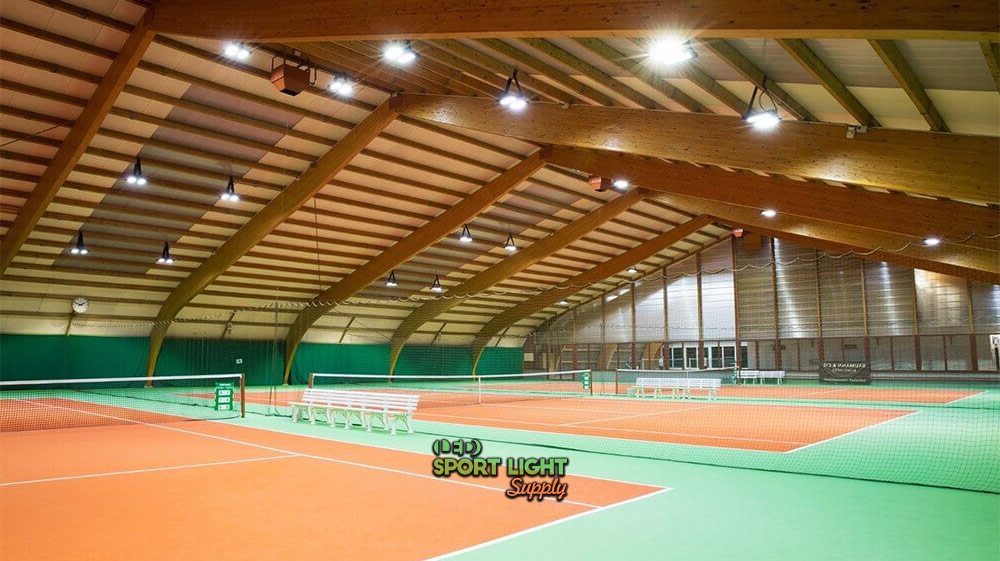
Light uniformity on a tennis court is crucial for ensuring consistent visibility across the playing surface. This involves plotting sections of the court on a grid and measuring the light levels in each section. The goal is to achieve even illumination across the court, minimizing weak spots and shadows.
To address areas with insufficient lighting, adjustments are made using a uniformity formula. This involves overlapping sections and fine-tuning the LED light output to ensure that all areas receive consistent light intensity. Achieving light uniformity is especially challenging in larger arenas but is essential for professional play. Tennis courts must meet specific uniformity levels as per IES and ISTA guidelines, with graphs and charts used to confirm compliance.
Glare Control
Glare control is important for both players and spectators. It involves managing the brightness and luminance levels to ensure that lighting is comfortable to view. The Glare Rating (GR) system evaluates the level of glare, with ratings ranging from 1 to 9. A middle-range rating is ideal for balancing visibility and comfort.
For professional tennis, a GR rating of around 50 is recommended, while high schools typically use a rating of 55. The Class I and II lighting systems generally use 4000K color temperature, whereas Class III uses 2000K. Proper glare control ensures that lighting enhances visibility without causing discomfort.
CRI & Color Temperature
The Color Rendering Index (CRI) measures how accurately lighting renders colors compared to natural daylight. For tennis courts, a CRI of 65 to 80 is ideal, with 80 being close to excellent. Lighting for professional courts is typically in the range of 2000-4000K.
Higher CRI values indicate better color accuracy, which is important for distinguishing the ball and court markings. School lighting may have a lower CRI but still maintains good visibility. The color temperature impacts the appearance of the lighting, with cooler white tones being common for Class III lighting.
Lux Levels
Lux measures the amount of light falling on a surface, and appropriate Lux levels are essential for optimal visibility. For professional tennis, Lux levels of 1000-1250 are ideal, providing daylight-like conditions. Semi-professional courts typically have Lux levels of 600-750, while high school courts have around 400-500 Lux.
Higher Lux levels are crucial for competitive play, where players need clear visibility for fast-moving action. Adequate Lux levels ensure that players can track the ball and respond quickly during matches.
Flicker Control
Flicker in LED lighting, caused by rapid pulsing of light, can affect visual comfort and performance. Modern LED lights are equipped with flicker control to eliminate visible flicker. Flicker is measured in Hertz (Hz), with high-frequency cycles (20,000-40,000Hz) used to ensure that the pulsing is imperceptible to the human eye.
Advanced digital cameras, used for broadcasting, can capture up to 2000 frames per second, which helps in assessing flicker. LED lighting’s efficiency in minimizing flicker ensures clear, consistent illumination for both players and television viewers.
Advantages of Using LED Tennis Court Lighting
LED lighting offers several significant advantages over traditional lighting methods, making it an increasingly popular choice for tennis courts. These benefits extend beyond just cost savings to include improvements in performance, durability, and user comfort.
Energy Efficiency
LED lighting is renowned for its energy efficiency. Unlike traditional lighting systems that rely on burning filaments or gases, LEDs use semiconductor technology to produce light. This method consumes significantly less power to generate the same amount of light. As a result, LEDs require fewer watts to deliver high-intensity illumination. When multiple LEDs are used together, they produce a bright, uniform light over a large area, making them an economical choice for tennis courts and other sports facilities.
Longer Lifespan
One of the most compelling reasons to switch to LED lighting is its extended lifespan. LEDs are designed with components that can endure for many years. Many LED fixtures are built with cooling vents that efficiently dissipate heat, thereby enhancing their longevity. With typical lifespans ranging from 15 years or more, LED lighting significantly outlasts traditional lighting options. This durability means that the initial investment in LED lighting pays off over time through reduced replacement and maintenance costs.
Higher Quality Uniformity
LED lighting provides superior light uniformity compared to traditional sources. This means that a tennis court can be evenly illuminated with minimal shadows or dark spots. Advanced LED systems allow for precise control over lighting distribution, ensuring that all areas of the court receive consistent light levels. This is particularly beneficial for professional and larger-scale installations where even illumination is crucial for optimal performance and player visibility.
Better Visual Appearance
LED lights enhance the visual quality of tennis courts, contributing to a better viewing experience. Modern LED systems can replicate daylight colors, providing a natural and comfortable viewing environment. This is essential for professional matches where players need to perform as if they were competing in daylight. Historically, older lighting technologies often produced harsh or uneven lighting that could be uncomfortable for both players and spectators. LED lighting addresses these issues with improved color temperature and light quality.
Minimal Insect Attraction
Another practical advantage of LED lighting is its minimal impact on insects. Unlike incandescent lights, which emit wavelengths that attract moths, mosquitoes, and other pests, LEDs do not produce the same heat signature or light spectrum that draws insects. This makes LED lighting ideal for outdoor settings like tennis courts, where reducing insect attraction enhances player comfort and overall enjoyment of night-time games.
What to Look for When Buying Tennis Court Lighting
When selecting lighting for a tennis court, several key factors should be considered to ensure optimal performance and efficiency. Here’s a detailed guide on what to look for when choosing tennis court lighting:
Type of Lighting
The type of lighting used significantly impacts performance and maintenance. Traditional options like high-intensity discharge (HID) lamps, including metal halide (MH), high-pressure sodium (HPS), and mercury lamps, are commonly used but have several drawbacks. These lamps require a warm-up time of 15-20 minutes and have a limited lifespan of around 3,000 hours, making them costly to replace.
In contrast, LED lighting is rapidly replacing these older technologies due to its superior benefits. LEDs are flicker-free with a wavelength of 20,000-40,000Hz, which is particularly advantageous for professional tennis players and coaches using slow-motion video analysis. The high-frequency flicker of LEDs ensures clear, flicker-free footage, which is essential for precise training and performance evaluation.
Luminous Efficiency
Luminous efficiency measures how effectively a light source converts electrical power into visible light. Traditional lighting sources, such as metal halide lamps, require more wattage to produce a given amount of light, resulting in higher electricity bills. For instance, a 1,000-watt metal halide lamp may initially provide 100,000 lumens but can drop to 50,000 lumens over time. In contrast, a 300-watt LED spotlight can deliver 40,000 lumens.
LED lights are designed to focus light in a 180-degree beam, minimizing light loss and improving efficiency. This focused beam ensures that the light is directed where it is needed, reducing spill light and enhancing coverage. Proper light placement is crucial to achieving effective illumination and minimizing waste.
Beam Angle
The beam angle of a lighting fixture determines the spread of light across the tennis court. LED sports lights typically offer beam angles ranging from 10 to 25 degrees, allowing for precise control over illumination. Smaller angles are used for focused, intensive lighting on the court, while wider angles are employed for general area lighting.
For tennis courts, careful consideration of beam angles is essential to ensure even coverage and avoid glare. A well-designed lighting system will include a combination of fixtures with varying beam angles to achieve comprehensive illumination, both on the court and for spectator areas.
Color Temperature
Color temperature affects both visibility and the overall playing experience. The standard color temperature for professional tennis courts is 4000K, which provides a natural white light similar to midday sunlight. This temperature enhances visual clarity and detail without causing harsh glare, making it ideal for high-level play.
For less demanding applications, such as high school courts, a color temperature of 2000K may be used. This warmer light resembles incandescent lighting and provides a more relaxed atmosphere, though it may not offer the same level of detail as 4000K light.
Instant On/Off Capability
LED lighting offers the advantage of instant on/off functionality, which is a significant improvement over older HID lamps that require a warm-up period of 15-20 minutes. Additionally, HID lamps need to cool down before being restarted, which can be problematic in case of power interruptions.
LED lights, on the other hand, can be switched on and off without delays or cooldown periods. This feature is particularly beneficial for professional matches and for scenarios where quick recovery from power outages is essential. Many tennis courts also use backup power supplies or solar panels with batteries to ensure uninterrupted lighting during power failures.
Anti-Glare Capabilities
Glare is a common issue with sports lighting, especially when overhead lights are involved, as they can cause significant visual discomfort. Addressing this problem involves using special optical glass and advanced lens focusing techniques. The primary strategy to minimize glare is to limit light spillover through precise LED focusing methods. This approach helps make overhead lights appear as clear beams rather than sources surrounded by halos.
For instance, on a tennis court, focusing light beams correctly ensures that the illumination appears sharp along the edges of the light fixtures. This reduces the likelihood of unfocused light causing glare. LEDs are particularly effective for this purpose because they can be focused using angled lenses, which effectively removes the appearance of glare. In large arenas, such as those used for professional tennis matches, anti-glare technology is essential to prevent players and spectators from being blinded by excessive light.
The effectiveness of anti-glare measures begins with the design of the LED light board and its positioning relative to the optical glass. Internal reflectors are employed to refocus stray light, which then passes through single-optic glass to produce a continuous, glare-free beam. This solution is especially useful for larger tennis courts where glare issues are more prominent.
Control System (DMX/DALI)
Lighting control systems like DMX and DALI are integral to managing lighting in large arenas, such as those hosting tennis tournaments and professional games. These systems allow for the integration of multiple light sources onto a single control board, enabling precise adjustments during events. For example, the system can dim audience lights while adjusting court lights as needed.
While this may seem more akin to a light show than a tennis match, such technology adds an element of theater to the event. Professional matches, which often attract large crowds, can benefit from this added layer of entertainment. The control systems allow for the dimming and raising of selected lights using simple on/off and slider switch controls.
DMX offers high-speed control and can manage up to 512 lights, with one channel per lamp. In contrast, DALI is a slower system that can control up to 64 lights. Depending on the scale and spectacle of the tennis match, DMX provides more advanced capabilities, whereas DALI offers a more basic level of control.
Installation
The installation of arena lights involves various considerations, particularly when upgrading or replacing fixtures. Unlike residential LED lights, which typically come with built-in mounting brackets, arena lights often require specific bracket variations to accommodate different mast shapes and sizes.
For smaller masts, mounting brackets are usually integrated into the light fixtures, allowing for easy adjustment and aiming. In contrast, taller masts necessitate more robust brackets designed to withstand high winds and other weather conditions. Indoor lights, on the other hand, are mounted using ceiling brackets attached directly to overhead beams or anchor points.
When ordering arena lights, it is crucial to verify the components included in the fixture package. This is important for those planning to mount lights on pole masts or ceilings. Custom orders may also require selecting the appropriate brackets. Typically, mounting bracket kits include all necessary nuts and bolts, but assembly is often not included.
The installation process is generally carried out by sports lighting professionals. The cost of installation depends on the complexity of the work involved.
Waterproof Features for Outdoor Tennis Courts
Outdoor tennis court lighting must withstand exposure to various weather conditions. For regions with dry climates, an IP65 rating, which provides protection against light drizzle and mist, may be sufficient. However, for areas experiencing regular rainfall, an IP66 rating is more appropriate as it offers higher water resistance.
For extreme conditions, such as areas with frequent heavy rain or locations near bodies of water, an IP67 rating is ideal. This rating indicates that the light fixtures are protected against complete submersion in water. IP67 fixtures are designed to prevent water ingress, which can damage LEDs, making them suitable for environments with high moisture levels, such as coastal or lakefront areas.
Warranty
A warranty is a crucial aspect of purchasing new tennis court lights. While the specifics can vary between manufacturers, many LED lighting producers offer robust warranty options. For example, Musco provides a 25-year warranty on all parts and labor, reflecting their confidence in their products.
Warranties typically include two components: a standard warranty for replacement parts and a lifetime warranty covering the fixture’s estimated lifespan. If an LED light fails within a specified period, such as 7 years, a new fixture may be provided. Larger sports lighting companies often offer extended warranties and emphasize strong customer service to support long-term business relationships. For residential tennis courts, warranties may not be as extensive unless the investment justifies long-term lighting service.
Tennis Court Lighting Layout
Lighting a tennis court requires careful consideration of several factors, including pole positioning, the number of poles, and the average height of the poles. Each element plays a crucial role in ensuring that the court is adequately illuminated for both recreational play and professional events.
Pole Position
The lighting layout for a tennis court depends heavily on the court’s design, whether it is a single or double court setup. Typically, the positions for lighting poles are determined during the planning phase. If poles are added later, specific considerations for electricity and base mountings need to be addressed separately. This information is provided to sports lighting contractors who specialize in tennis court lighting.
The arrangement of the light poles is primarily based on the amount of illumination required to cover the entire court. Sports lighting contractors are adept at calculating the optimal number of poles and their placement to ensure uniform lighting. They use their expertise to determine how much light each fixture can deliver and adjust the layout accordingly.
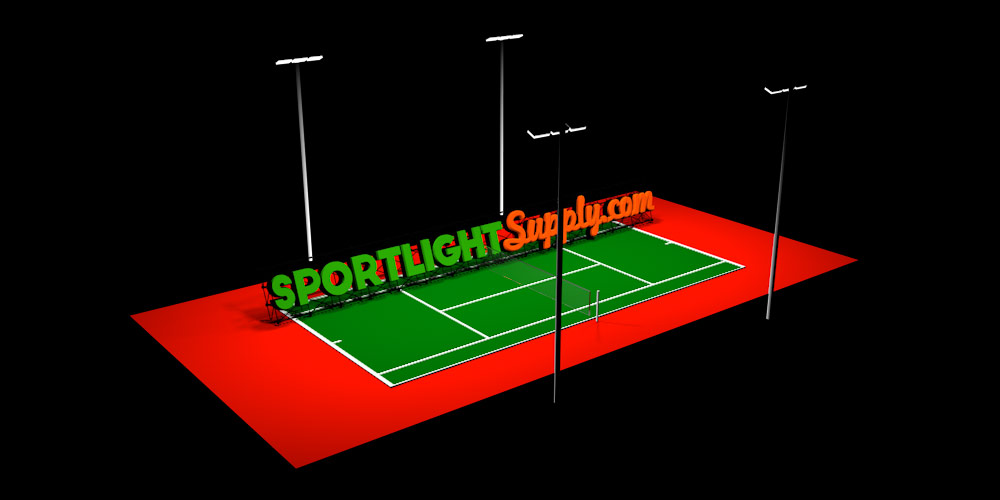
Number of Poles
For a single tennis court, the number of light poles can vary between four and eight. Generally, having more poles increases the likelihood of achieving uniform lighting across the court. However, with advanced LED technology, it’s possible to achieve excellent results with fewer poles. For instance, high-quality LED fixtures might only require four poles to provide sufficient illumination, while others might need up to six.
The choice of the number of poles depends on various factors, including the specific lighting needs of the court and the height of the poles.
Average Height
The height of light poles is an important consideration in tennis court lighting. For residential courts, the recommended pole height is between 18 and 22 feet. In contrast, recreational clubs may use poles that are approximately 30 feet tall. Professional arenas often require much taller poles, ranging from 50 to 100 feet, depending on the arena’s design and requirements.
Tennis Court Pole Light Mounting
Poles for Outdoor Courts
Outdoor tennis courts require a concrete base with exposed mounting bolts for the light poles. The power supply for the lights must be routed from each base location to the poles. Exposed bolts are used for connecting and mounting the poles. In some areas, tree poles may be used if local construction laws permit. The materials for the poles can vary, including metal, molded resin, or fiber, depending on the chosen style.
Older metal poles can be refurbished and repainted if they appear worn. The height of the pole is an important factor when replacing old fixtures to ensure proper illumination.
Ceiling Mounts for Indoor Courts
For indoor tennis courts, light fixtures are typically mounted to overhead beams or supports. If the height allows, mounting along the walls is also an option. Electrical cables are connected by running them from the main power source to the light fixtures. A qualified tennis court lighting electrician should determine the combined wattage requirements before installation.
Each light fixture must be securely attached to the ceiling mount. Proper installation ensures that the fixtures are stable and aligned correctly.
Average Lamp and Installation Costs
The cost of tennis court lighting is influenced by the wattage of the fixtures. Higher wattage typically corresponds to a higher fixture price. For example, a 100-watt LED light generally costs around $120 per unit. As the wattage increases, so does the cost. Metal halide lights, which are often less expensive, typically cost about $50 per unit for 1000 watts. While brand name units may be more costly, they often come with extended warranties, which can last for decades rather than just a few years.
Installation costs are significant and can vary widely. Professional contractors are often required for proper installation, and their fees can be substantial. To minimize costs, it’s advisable to compare quotes from different tennis lighting contractors. Homeowners should consider purchasing all necessary supplies in advance to avoid hidden mark-ups and keep installation costs within budget.
Calling a Tennis Court Lighting Contractor vs. Self-Installation: Pros and Cons
The question of whether it’s a good idea to call a professional or do-it-yourself is always debatable. There are things that you might not know about electrical wiring and lighting configuration.
| Option | Pros | Cons |
|---|---|---|
| Calling a Contractor |
|
|
| Self-Installation |
|
|
Tennis Court Lighting Q&A
How Many Lumens Are Needed for a Tennis Court?
For a residential tennis court, which typically measures 120 feet by 60 feet (approximately 7,200 square feet or 195 square meters), a lighting level of 300,000 to 400,000 lumens is required to ensure adequate illumination. This lumens range ensures that flood lights effectively cover the entire playing area, providing sufficient visibility for players.
What Is the Cost of Running Tennis Court Lighting?
The cost of operating tennis court lighting depends on the type of fixtures used and their number. For LED fixtures, the cost is approximately 12 cents per fixture per day if the lights are used for 8 hours. This translates to about $155 annually per fixture. With a minimum setup of four lights, the daily cost would be 48 cents, totaling around $620 per year. If the lights are used for only 4 hours per evening, the annual cost would drop to approximately $320. In contrast, metal halide fixtures can be significantly more expensive, with costs reaching up to $400 per lamp.
How to Replace Older Tennis Court Lighting?
Replacing older metal halide (MH) or high-pressure sodium (HPS) lights with LED fixtures can result in significant energy savings. LED lamps, typically rated at 100 watts, replace 1000-watt MH or HPS lamps. The energy savings can amount to nearly $1,000 per year. Over a 20-year period, this could lead to additional savings of around $20,000, considering that LED lights have a longer lifespan.
How to Turn On Tennis Court Lights?
The method for turning on tennis court lights varies based on the lighting system installed. Many systems offer manual controls, while more advanced setups can be operated via smartphone apps. Having both options provides flexibility, ensuring you can manage lighting even if your smartphone is not available. Additionally, many systems allow for programming the lights to turn on automatically at set times.
What Is the Best Color Temperature for Tennis Court Lights?
The choice of color temperature for tennis court lights depends on personal preference and the level of play. Residential courts typically use lights with a color temperature of 2000K, which is warmer and more relaxing. For professional and semi-professional courts, a color temperature of 4000K is preferred due to its higher color rendering index (CRI) and lux levels, which enhance visibility and reduce glare.
Is There a Difference Between Residential and Professional Tennis Lighting?
Yes, there are notable differences between residential and professional tennis lighting. Professional courts often use specialized LED fixtures designed with anti-glare technology to minimize halo effects from high-mast poles, which are commonly 50 feet above the court. In contrast, residential courts typically use fixtures that are mounted on poles no taller than 18 to 22 feet and may not have the same anti-glare features.
How Far Should Light Posts Be Placed Outside a Tennis Court?
For optimal lighting coverage, light posts are generally placed 6 feet outside the sidelines and 10 feet behind the baselines of a tennis court. For a standard residential court measuring 120 feet by 60 feet, this placement ensures even illumination. While most residential courts use four LED lights, higher-end or professional setups may require 6 to 8 lights. Additional lighting may be installed in areas such as rest zones or equipment storage rooms if needed.
Conclusion
Modern tennis court lighting, particularly LED technology, has revolutionized how the game is played and viewed. From enhancing visibility for players to improving the spectator experience, advanced lighting ensures that tennis can be enjoyed both day and night. LED systems offer energy efficiency, long lifespan, and excellent light uniformity, making them ideal for various applications from residential to professional courts. As tennis continues to evolve, so does the technology that supports it, ensuring high-quality play and viewing at any time.
